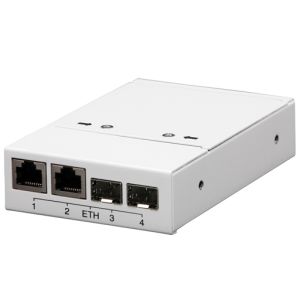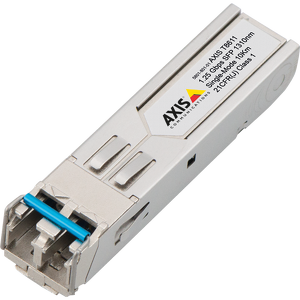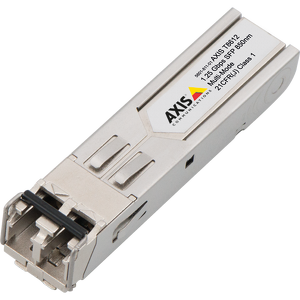AXIS Fiber Medienkonverter

AXIS T8604 Medienkonverter-Switch
AXIS T8604 Medienkonverter-Switch

AXIS T8604 Medienkonverter-Switch
Von Ethernet auf eine schnelle Lichtwellenleiter-Übertragung über große Entfernungen
- Glasfaser zu Ethernet konvertieren
- Kompatibel zu Netzwerk-Videoprodukten von Axis
- Unterstützung für 10/100 Mbps
- Zuverlässige Konfiguration
- Zwei SFP-Anschlüsse und zwei RJ-45-Ports
Von Ethernet zu Glasfaser
 Der Medienkonverter-Switch kann an ein Netzwerk in Linien-Topologie (Daisy Chain) angeschlossen werden. Die maximale Anzahl der Kameras, die in dieser Verkettung angeschlossen werden können, hängt von der erzeugten Bitrate pro Kamera ab. Die Geschwindigkeit ist zwischen Kamera und Medienkonverter-Switch durch die 100-MBit-Verbindung und zwischen den Medienkonverter-Switches untereinander durch die 1.000-MBit-Verbindung begrenzt. Der AXIS T8604 verfügt über keine IGMP-Snooping-Funktionalität.
Der Medienkonverter-Switch kann an ein Netzwerk in Linien-Topologie (Daisy Chain) angeschlossen werden. Die maximale Anzahl der Kameras, die in dieser Verkettung angeschlossen werden können, hängt von der erzeugten Bitrate pro Kamera ab. Die Geschwindigkeit ist zwischen Kamera und Medienkonverter-Switch durch die 100-MBit-Verbindung und zwischen den Medienkonverter-Switches untereinander durch die 1.000-MBit-Verbindung begrenzt. Der AXIS T8604 verfügt über keine IGMP-Snooping-Funktionalität.
Für Verbindungen über große Entfernungen
Lichtwellenleiter werden üblicherweise in städtischen Überwachungsanlagen, an Flughäfen und sonstigen Großinstallationen eingesetzt, wo die Gefahr von Blitzeinschlägen besteht oder große Entfernungen überwunden werden müssen. Zur Wartung und Kontrolle der Kameras können Errichter und Systemintegratoren vor Ort Installationsmonitore und Laptops am AXIS T8604 anschließen.
Einfache Konvertierung und Installation
 Der Medienkonverter-Switch ist mit allen Axis Netzwerk-Videoprodukten kompatibel. Eine Axis-Kamera oder ein Encoder wird per RJ-45 an den AXIS T8604 angeschlossen. Über zwei SFP-Anschlüsse können Monteure die Kameras flexibel und kostengünstig über lange Distanzen hinweg mit dem Netzwerk verbinden. Über die RJ45-Anschlüsse können zudem zusätzliche Kameras oder vorübergehend ein Laptop angeschlossen werden, um das System vor Ort zu warten.
Der Medienkonverter-Switch ist mit allen Axis Netzwerk-Videoprodukten kompatibel. Eine Axis-Kamera oder ein Encoder wird per RJ-45 an den AXIS T8604 angeschlossen. Über zwei SFP-Anschlüsse können Monteure die Kameras flexibel und kostengünstig über lange Distanzen hinweg mit dem Netzwerk verbinden. Über die RJ45-Anschlüsse können zudem zusätzliche Kameras oder vorübergehend ein Laptop angeschlossen werden, um das System vor Ort zu warten.
Typische Einrichtung:


AXIS T8606 Media Converter-Switch 24 V Gleichstrom
AXIS T8606 Media Converter-Switch 24 V Gleichstrom

AXIS T8606 Media Converter-Switch 24 V Gleichstrom
Vom Ethernet zur schnellen Langstrecken-Glasfaserverbindung
- EINGANG 24 V Gleichstrom
- Ethernetsignale für Glasfaserverbindungen umwandeln
- Kompatibel mit Netzwerkvideoprodukten von Axis
- Unterstützt 10/100 MBit/s
- Zwei SFP-Steckplätze und zwei RJ-45-Ports
Vom Ethernet zur Glasfaser
 Der Media-Converter-Switch kann in einem Daisy Chain-Netzwerk angeschlossen werden. Die maximale Anzahl der Kameras, die in diesem Daisy Chain-Netzwerk angeschlossen werden können, hängt von der pro Kamera erzeugten Bitrate ab. Begrenzungen sind die 100 Mbit-Datenverbindung zwischen Kamera und Media Converter-Switch und die 1000 Mbit-Datenverbindung zwischen den Media Konverter-Switches.
AXIS T8606 unterstützt kein IGMP Snooping.
Der Media-Converter-Switch kann in einem Daisy Chain-Netzwerk angeschlossen werden. Die maximale Anzahl der Kameras, die in diesem Daisy Chain-Netzwerk angeschlossen werden können, hängt von der pro Kamera erzeugten Bitrate ab. Begrenzungen sind die 100 Mbit-Datenverbindung zwischen Kamera und Media Converter-Switch und die 1000 Mbit-Datenverbindung zwischen den Media Konverter-Switches.
AXIS T8606 unterstützt kein IGMP Snooping.
Einfacher Umbau, schnelle Installation
 Der Media-Konverter-Switch ist mit allen Netzwerkvideoprodukten von Axis kompatibel Das Produkt wird über RJ-45 an AXIS T8606 angeschlossen. Über zwei SFP-Anschlüsse können Monteure die Kameras flexibel und kostengünstig über große Entfernungen hinweg mit dem Netzwerk verbinden. Über die Anschlüsse des Typs RJ-45 können ergänzende Kameras oder auch vorübergehend Laptops zur Wartung des Systems vor Ort angeschlossen werden. AXIS T8606 kann auch mit dem DIN-Schienenclip A AXIS T91A03 einfach gemäß DIN installiert werden.
Der Media-Konverter-Switch ist mit allen Netzwerkvideoprodukten von Axis kompatibel Das Produkt wird über RJ-45 an AXIS T8606 angeschlossen. Über zwei SFP-Anschlüsse können Monteure die Kameras flexibel und kostengünstig über große Entfernungen hinweg mit dem Netzwerk verbinden. Über die Anschlüsse des Typs RJ-45 können ergänzende Kameras oder auch vorübergehend Laptops zur Wartung des Systems vor Ort angeschlossen werden. AXIS T8606 kann auch mit dem DIN-Schienenclip A AXIS T91A03 einfach gemäß DIN installiert werden.
Typische Einrichtung:


AXIS T8611 SFP Module LC.LX
AXIS T8611 SFP Module LC.LX

AXIS T8611 SFP Module LC.LX
Single-mode fiber module for up to 10 km transmission range
- Up to 10 km range
- Single-mode fiber
- Link-loss feature
- Industrial grade – extended temperature range
- Complies with SFP MSA
AXIS T8611 SFP Module LC.LX is a small form-factor pluggable (SFP) transceiver that supplies network devices, such as a switches or routers, with a fiber optic network connection. It is industrial grade with a wide temperature range (between -40 °C to 65°C), and it includes loss of signal feature that enable network redundancy.
Complying with SFP Multisource Agreement (MSA), it is easy to install into compliant ports at any time without interrupting the online operation of the host equipment. Long wavelength (1,310 nm) FP laser diodes enable data transmission up to 10 km on a single-mode 9/125 μm optical fiber. The module is tested and verified with Axis products such as AXIS T8516 PoE+ Network Switch.
Link-loss feature for network redundancy
The loss of signal (LOS) feature allows for the system to recognize a lost connection between a specific hardware (For example, AXIS Network Cameras) and the host. For optimized network redundancy, AXIS T8611 signals the hardware in case of a lost connection or unusable connection for network traffic. This allows for the hardware to redirect the network traffic through a fallback connection, for example via RJ45.
For long distance Connections
Fiber optic connections are typically used in city surveillance, airports and other long distance installations, where lighting strikes are a threat or great connection distances are required.

AXIS T8612 SFP Module LC.SX
AXIS T8612 SFP Module LC.SX

AXIS T8612 SFP Module LC.SX
Multi-mode fiber module for up to 550 m transmission range
- Up to 550 m range
- Multi-mode fiber
- Link-loss feature
- Industrial grade – extended temperature range
- Complies with SFP MSA
AXIS T8612 SFP Module LC.SX is a small form-factor pluggable (SFP) transceiver that supplies network devices, such as a switches or routers, with a fiber optic network connection. It is industrial grade with a wide temperature range (between -40 °C to 65°C), and it includes loss of signal feature that enable network redundancy.
Complying with SFP Multisource Agreement (MSA), it is easy to install into compliant ports at any time without interrupting the online operation of the host equipment. Short wavelength (850 nm) VCSEL laser diodes enable data transmission up to 550 m on a multimode 50/125 μm optical fiber. The module is tested and verified with Axis products such as AXIS T8516 PoE+ Network Switch.
Link-loss feature for network redundancy
The loss of signal (LOS) feature allows for the system to recognize a lost connection between a specific hardware (For example, AXIS Network Cameras) and the host. For optimized network redundancy, AXIS T8612 signals the hardware in case of a lost connection or unusable connection for network traffic. This allows for the hardware to redirect the network traffic through a fallback connection, for example via RJ45.
For long distance connections
Fiber optic connections are typically used in city surveillance, airports and other long distance installations, where lighting strikes are a threat or great connection distances are required.
